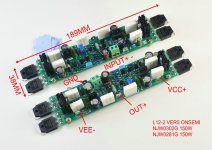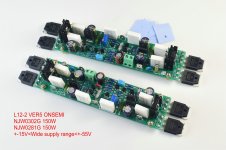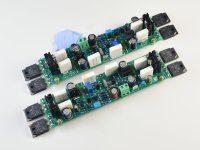I have read a lot of audiophile articles that mention this coupling. It enhances the pulse behaviour and the highs. Don't be sorry Anatech, I am very pleased with the sound of my amplifier and it is the most important.
That's cool.
Proved and measured performance disagrees with audiophile reports. So much is reported as an improvement. Almost none of it passes logical thinking or properly measured testing. If you understand how the components work, and what is going on, the answers are extremely clear and easy to understand.
I mention this as I constantly have to remove added parts as they create a mess and sometimes other issues. It is sad when client has spent a great deal of money on "better parts" and end up with the same or poorer performance. Always because an "expert" reads off the internet and charges too much for their efforts.
Proved and measured performance disagrees with audiophile reports. So much is reported as an improvement. Almost none of it passes logical thinking or properly measured testing. If you understand how the components work, and what is going on, the answers are extremely clear and easy to understand.
I mention this as I constantly have to remove added parts as they create a mess and sometimes other issues. It is sad when client has spent a great deal of money on "better parts" and end up with the same or poorer performance. Always because an "expert" reads off the internet and charges too much for their efforts.
Type II ceramic counts as really horrible quality in my book - they have hysteresis which can look rather like crossover distortion.The Wima does nothing. Sorry.
Unless a coupling cap is defective or really horrible quality, it has no effect on audio. That's assuming it is sized correctly of course.
I'll agree Mark.
High "K" ceramics are gruesome, as are solid tantalum (wet tantalum are very good in contrast). Remember when solid tantalum caps were all the rage? Audiophiles reported good things. High end manufacturers flocked to them.
So much for audiophile listening tests! lol!
High "K" ceramics are gruesome, as are solid tantalum (wet tantalum are very good in contrast). Remember when solid tantalum caps were all the rage? Audiophiles reported good things. High end manufacturers flocked to them.
So much for audiophile listening tests! lol!
After some decades in making, mixing and mastering Music, ears are my only judge...
That fits for what you are doing - creating music.
We are reproducing music, massive difference. I work in recording studios too, for decades.
So if your ears are your only judge, you are missing at least 1/2 the important information. We all use test instruments and listening. The instruments keep our ears and brain from lying to us. It all works together. You are not doing a remix with the beds. You aren't laying the tracks down again. You are recreating the mix as the engineer and producer crafted it. Distortion is a bad thing. By definition it changes the original sound.
If this is your thing individually, that's cool. But it sure isn't right for most of the folks out there.
We are reproducing music, massive difference. I work in recording studios too, for decades.
So if your ears are your only judge, you are missing at least 1/2 the important information. We all use test instruments and listening. The instruments keep our ears and brain from lying to us. It all works together. You are not doing a remix with the beds. You aren't laying the tracks down again. You are recreating the mix as the engineer and producer crafted it. Distortion is a bad thing. By definition it changes the original sound.
If this is your thing individually, that's cool. But it sure isn't right for most of the folks out there.
Taobao will scam you in a heartbeat! I lost $280 years ago by ordering directly on their website. If you must use Taobao, go through a 3rd party buyer. They charge a fee, but at least you'll get the product.Hi,
good info 👍
I wished LJM would offer another webshop possibilty ... Taobao is difficult ... almost impossible for me anyway ... to access here.
Alixpress or ebay would reach out to a more global customer list.
jauu
Calvin
There are many many AliExpress sellers selling the board, assembled with genuine Sanken o/p devices for around $25 a pair.
Hi...
the best way....avoid the LJM boards and other, exept the old LJM L20.5, all other boards from the Chinese sellers need changes, mods.
I think it was "Ostripper" who mentioned.."Lazy Design"
The Chinese minimize if they can and save. No problems with heat and safety and so on...thats a fact..
It was my way too in the beginning to buy assembled boards, but i had to learn.
In the forum here are presented very good amps, okay not as a finished board, but soldering is no witchcraft...
Before you get annoyed afterwards...
But everyone can decide for its own....🙂
Greets
Peter
the best way....avoid the LJM boards and other, exept the old LJM L20.5, all other boards from the Chinese sellers need changes, mods.
I think it was "Ostripper" who mentioned.."Lazy Design"
The Chinese minimize if they can and save. No problems with heat and safety and so on...thats a fact..
It was my way too in the beginning to buy assembled boards, but i had to learn.
In the forum here are presented very good amps, okay not as a finished board, but soldering is no witchcraft...
Before you get annoyed afterwards...
But everyone can decide for its own....🙂
Greets
Peter
The design is actually performing very well against the investment!!!!! Layzy design or not.
I bought 120 of these channels for a custom project for OEM active speakers. It was one of the very first of the L12-2 versions. I bought them with the original Sanken output devices and good quality elco’s.
Couldn’t find anything on the market for $10,- per channel that was as robust, had current and power to spare with relatively low distortion under various loads.
Did not keep track of the later versions and the completely assembled boards after the project finished.
These powered speakers are in operation for >6 years and no failure or complaint received.
I bought 120 of these channels for a custom project for OEM active speakers. It was one of the very first of the L12-2 versions. I bought them with the original Sanken output devices and good quality elco’s.
Couldn’t find anything on the market for $10,- per channel that was as robust, had current and power to spare with relatively low distortion under various loads.
Did not keep track of the later versions and the completely assembled boards after the project finished.
These powered speakers are in operation for >6 years and no failure or complaint received.
I design my own and make the surface mount boards. Not frightened of soldering after 50 years in the industry Peter 🙂but soldering is no witchcraft...
#
I try too...PCB design i can do....electronic, mhmm, i have to learn so much more...
Have fun..
Have fun..
There are many books and online resources to learn the basics, but for Audio, a copy of Bob Cordell's book and of Doug Self's book will teach you much. At 72 years old, I still learn new knowledge all the time.
This is an introduction to the L12-2 VER5 version
Replace the low-power transistors B649 and D669 with medium-power transistors A1837 and C4793.
Increase the static current of the drive power transistors from 6mA to 18mA.
Add a heat sink to the medium-power transistors.
Add a static current adjustment function for the output power transistors to make the static current of the left and right channel circuit boards the same.
Use electronic filters to replace the previous RC passive filters to reduce interference at the input stage.
Change the input stage method to increase the input impedance and enhance low-frequency performance.
Replace the low-power transistors B649 and D669 with medium-power transistors A1837 and C4793.
Increase the static current of the drive power transistors from 6mA to 18mA.
Add a heat sink to the medium-power transistors.
Add a static current adjustment function for the output power transistors to make the static current of the left and right channel circuit boards the same.
Use electronic filters to replace the previous RC passive filters to reduce interference at the input stage.
Change the input stage method to increase the input impedance and enhance low-frequency performance.
Attachments
I would like to see the FULL circuit before I and many of my YouTube viewers will purchase. I'm really fed up with having to spend hours reverse engineering these circuits.
- Home
- Amplifiers
- Solid State
- L12-2 CFP Output amp 120W*2 8R


